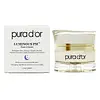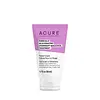What's inside
What's inside
 Key Ingredients
Key Ingredients

 Benefits
Benefits

 Concerns
Concerns

 Ingredients Side-by-side
Ingredients Side-by-side

Aloe Barbadensis Leaf Juice
Skin ConditioningWater
Skin ConditioningHyaluronic Acid
HumectantXanthan Gum
EmulsifyingPyrus Malus Fruit Extract
Skin ConditioningGlycerin
HumectantOryza Sativa Bran Extract
Skin ConditioningRosmarinus Officinalis Leaf Extract
AntimicrobialHelianthus Annuus Extract
EmollientTocopherol
AntioxidantEthylhexyl Olivate
Skin ConditioningSqualane
EmollientCaprylic/Capric Triglyceride
MaskingLinoleic Acid
CleansingGlycine Soja Sterols
EmollientPhospholipids
Skin ConditioningStearyl Glycyrrhetinate
Skin ConditioningGlyceryl Stearate
EmollientCetearyl Phosphate
Skin ConditioningCetyl Alcohol
EmollientRetinol
Skin ConditioningMacrocystis Pyrifera Extract
Skin ConditioningGlycyrrhiza Glabra Root Extract
BleachingNiacinamide
SmoothingResveratrol
AntioxidantMalus Domestica Fruit Cell Culture Extract
Skin ConditioningLecithin
EmollientPisum Sativum Peptide
Skin ConditioningLeuconostoc/Radish Root Ferment Filtrate
AntimicrobialCI 52015
Propanediol
SolventChlorella Vulgaris Extract
Skin ConditioningLactic Acid
BufferingLavandula Angustifolia Oil
MaskingSalvia Sclarea Oil
MaskingCitrus Paradisi Peel Oil
MaskingCymbopogon Citratus Leaf Oil
MaskingPhenoxyethanol
PreservativeCaprylyl Glycol
EmollientEthylhexylglycerin
Skin ConditioningHexylene Glycol
EmulsifyingAloe Barbadensis Leaf Juice, Water, Hyaluronic Acid, Xanthan Gum, Pyrus Malus Fruit Extract, Glycerin, Oryza Sativa Bran Extract, Rosmarinus Officinalis Leaf Extract, Helianthus Annuus Extract, Tocopherol, Ethylhexyl Olivate, Squalane, Caprylic/Capric Triglyceride, Linoleic Acid, Glycine Soja Sterols, Phospholipids, Stearyl Glycyrrhetinate, Glyceryl Stearate, Cetearyl Phosphate, Cetyl Alcohol, Retinol, Macrocystis Pyrifera Extract, Glycyrrhiza Glabra Root Extract, Niacinamide, Resveratrol, Malus Domestica Fruit Cell Culture Extract, Lecithin, Pisum Sativum Peptide, Leuconostoc/Radish Root Ferment Filtrate, CI 52015, Propanediol, Chlorella Vulgaris Extract, Lactic Acid, Lavandula Angustifolia Oil, Salvia Sclarea Oil, Citrus Paradisi Peel Oil, Cymbopogon Citratus Leaf Oil, Phenoxyethanol, Caprylyl Glycol, Ethylhexylglycerin, Hexylene Glycol
Water
Skin ConditioningCetearyl Alcohol
EmollientCarthamus Tinctorius Seed Oil
MaskingGlyceryl Stearate Citrate
EmollientCocoglycerides
EmollientAloe Barbadensis Leaf Juice
Skin ConditioningBakuchiol
AntimicrobialHelianthus Annuus Seed Oil
EmollientGlyceryl Laurate
EmollientTheobroma Cacao Seed Butter
EmollientSqualane
EmollientTocopherol
AntioxidantTocopheryl Acetate
AntioxidantOenothera Biennis Oil
EmollientArgania Spinosa Kernel Oil
EmollientChamomilla Recutita Flower Extract
MaskingCalendula Officinalis Flower Extract
MaskingGlycerin
HumectantSodium Anisate
AntimicrobialXanthan Gum
EmulsifyingSodium Levulinate
Skin ConditioningGlyceryl Caprylate
EmollientSodium Phytate
Potassium Sorbate
PreservativeCitric Acid
BufferingWater, Cetearyl Alcohol, Carthamus Tinctorius Seed Oil, Glyceryl Stearate Citrate, Cocoglycerides, Aloe Barbadensis Leaf Juice, Bakuchiol, Helianthus Annuus Seed Oil, Glyceryl Laurate, Theobroma Cacao Seed Butter, Squalane, Tocopherol, Tocopheryl Acetate, Oenothera Biennis Oil, Argania Spinosa Kernel Oil, Chamomilla Recutita Flower Extract, Calendula Officinalis Flower Extract, Glycerin, Sodium Anisate, Xanthan Gum, Sodium Levulinate, Glyceryl Caprylate, Sodium Phytate, Potassium Sorbate, Citric Acid
 Reviews
Reviews

Ingredients Explained
These ingredients are found in both products.
Ingredients higher up in an ingredient list are typically present in a larger amount.
Aloe Barbadensis Leaf Juice comes from leaves of the aloe plant. Aloe Barbadensis Leaf Juice is best known for helping to soothe sunburns. It is also anti-inflammatory, moisturizing, antiseptic, and can help heal wounds.
Aloe is packed with good stuff including Vitamins A, C, and E. These vitamins are antioxidants, which help fight free-radicals and the damage they may cause. Free-radicals are molecules that may damage your skin cells, such as pollution.
Aloe Barbadensis Leaf Juice also contains sugars. These sugars come in the form of monosaccharides and polysaccharides, folic acid, and choline. These sugars are able to help bind moisture to skin.
It also contains minerals such as calcium, 12 anthraquinones, fatty acids, amino acids, and Vitamin B12.
Learn more about Aloe Barbadensis Leaf JuiceGlycerin is already naturally found in your skin. It helps moisturize and protect your skin.
A study from 2016 found glycerin to be more effective as a humectant than AHAs and hyaluronic acid.
As a humectant, it helps the skin stay hydrated by pulling moisture to your skin. The low molecular weight of glycerin allows it to pull moisture into the deeper layers of your skin.
Hydrated skin improves your skin barrier; Your skin barrier helps protect against irritants and bacteria.
Glycerin has also been found to have antimicrobial and antiviral properties. Due to these properties, glycerin is often used in wound and burn treatments.
In cosmetics, glycerin is usually derived from plants such as soybean or palm. However, it can also be sourced from animals, such as tallow or animal fat.
This ingredient is organic, colorless, odorless, and non-toxic.
Glycerin is the name for this ingredient in American English. British English uses Glycerol/Glycerine.
Learn more about GlycerinSqualane is an emollient that helps the skin hold onto moisture. It's an oily liquid that occurs naturally in certain types of fish and plant oils.
Because squalane boosts hydration in the skin, it also comes with plenty of benefits: it is an antioxidant and can help fight free radicals and skin damage. Squalane is also found to have a detoxifying effect when applied.
Squalane comes from squalene, which occurs naturally within the sebum of our skin. It is one of the oils our skin produces to keep itself hydrated. Squalane is the hydrogenated version of squalene and has a longer shelf life.
Research shows that squalane is non-irritating (even at 100% concentration).
In general, it's a fantastic ingredient. It does a great job at hydrating the skin, and it's suitable for those with sensitive skin.
The source of squalane may impact malassezia / fungal acne. This is because olive oil derived squalane can contain impurities such as fatty acids and plant waxes. Sugarcane derived squalane is recommended for anyone with malassezia concerns.
Is squalane vegan?
This depends on the source. Squalane can be derived from both plants and animals. Most squalane used in skincare comes from plants.
Please note: the source of squalane is only known if disclosed by the brand. We recommend reaching out to the brand if you have any questions about their squalane.
Read more about squalene with an "e".
Is squalane an oil?
Squalane is often called an oil, but it’s technically not; it’s a hydrocarbon, meaning it’s only made of carbon and hydrogen, unlike true oils which are triglycerides made of fatty acids and glycerol.
The term “oil-free” isn’t regulated, so companies can define it however they want. Some exclude all oils, while others just avoid mineral oil or comedogenic oils.
While some people avoid oils thinking they cause breakouts, the right kind of oil (or oil-like ingredient like squalane) can actually help balance and hydrate your skin. It’s worth testing out simple oils or squalane to see what works best for your skin.
Learn more about SqualaneTocopherol (also known as Vitamin E) is a common antioxidant used to help protect the skin from free-radicals and strengthen the skin barrier. It's also fat soluble - this means our skin is great at absorbing it.
Vitamin E also helps keep your natural skin lipids healthy. Your lipid skin barrier naturally consists of lipids, ceramides, and fatty acids. Vitamin E offers extra protection for your skin’s lipid barrier, keeping your skin healthy and nourished.
Another benefit is a bit of UV protection. Vitamin E helps reduce the damage caused by UVB rays. (It should not replace your sunscreen). Combining it with Vitamin C can decrease sunburned cells and hyperpigmentation after UV exposure.
You might have noticed Vitamin E + C often paired together. This is because it is great at stabilizing Vitamin C. Using the two together helps increase the effectiveness of both ingredients.
There are often claims that Vitamin E can reduce/prevent scarring, but these claims haven't been confirmed by scientific research.
Learn more about TocopherolWater. It's the most common cosmetic ingredient of all. You'll usually see it at the top of ingredient lists, meaning that it makes up the largest part of the product.
So why is it so popular? Water most often acts as a solvent - this means that it helps dissolve other ingredients into the formulation.
You'll also recognize water as that liquid we all need to stay alive. If you see this, drink a glass of water. Stay hydrated!
Learn more about WaterXanthan gum is used as a stabilizer and thickener within cosmetic products. It helps give products a sticky, thick feeling - preventing them from being too runny.
On the technical side of things, xanthan gum is a polysaccharide - a combination consisting of multiple sugar molecules bonded together.
Xanthan gum is a pretty common and great ingredient. It is a natural, non-toxic, non-irritating ingredient that is also commonly used in food products.
Learn more about Xanthan Gum